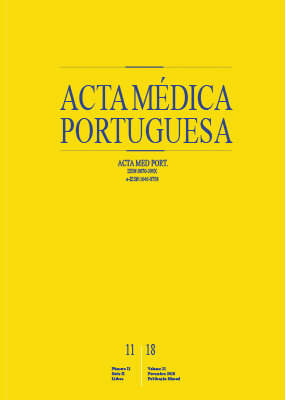Subtipos Histológicos e Avaliação do Comportamento Clínico de Tumores das Glândulas Salivares
DOI:
https://doi.org/10.20344/amp.9023Palavras-chave:
Glândulas Salivares/patologia, Neoplasias das Glândulas Salivares/patologiaResumo
Introdução: Os tumores das glândulas salivares incluem um vasto espetro de subtipos histológicos e comportamento clínico que pretendemos avaliar.
Material e Métodos: Realizou-se um estudo retrospetivo de todos os tumores das glândulas salivares diagnosticados e tratados no Centro Hospitalar São João, Porto, entre 2005 e 2015. Realizou-se reavaliação histológica de todos os casos. Os processos clínicos foram consultados e foram colhidos dados clínicos e de follow-up. A sobrevida livre de doença e a sobrevida global foram avaliadas usando as curvas de sobrevida de Kaplan-Meier e comparadas com o teste de log-rank Mantel-Cox. O limiar de significância foi estabelecido em 0,05.
Resultados: Selecionaram-se 295 casos, 150 no género masculino, com idade média de 50,4 anos. Nos tumores epiteliais benignos [n = 228 (77,3%)] predominaram os adenomas pleomórficos [n = 148 (64,9%)] e os tumores de Warthin [n = 61 (26,8%)]. Os tumores epiteliais malignos primários [n = 43 (14,8%)] incluíram carcinomas mucoepidermoides [n = 16 (37,2%)], adenoide-císticos [n = 6 (14,0%)] e de células acinares [n = 5 (11,6%)]; 32 (74,4%) localizaram-se na parótida, dois (4,6%) na submandibular e nove (21%) nas glândulas salivares minor. Os tumores epiteliais primários foram mais frequentemente malignos nas glândulas salivares minor (33,3%) do que nas major (13,9%). Observou-se recidiva local em 30,3% e metástases em 25,6%. O intervalo médio livre de doença foi 26 meses. As metástases mais frequentes ocorreram no pulmão e no sistema nervoso central. A taxa de sobrevida livre de doença aos cinco e 10 anos foi 63,4% e 50,1%, respetivamente; a sobrevida aos cinco e 10 anos foi 76,9% e 57,9%, respetivamente. Nos tumores primários identificaram-se também linfomas [n = 8 (2,7%)] e tumores mesenquimatosos [n = 5 (1,7%)]; nos tumores secundários identificaram-se metástases de carcinoma [n = 7 (2,4%)] e envolvimento por linfoma [n = 1 (0,3%)].
Discussão: Estes resultados assemelham-se aos da literatura europeia, designadamente quanto à idade, género, subtipo histológico e comportamento clínico. As divergências com séries portuguesas podem relacionar-se com critérios de inclusão, enviesamentos de referenciação clínica e período dos estudos.
Conclusão: Os tumores das glândulas salivares, embora raros, ocorrem numa faixa etária ampla, incluindo subtipos histológicos com prognósticos diferentes.
Downloads
Downloads
Publicado
Como Citar
Edição
Secção
Licença
Todos os artigos publicados na AMP são de acesso aberto e cumprem os requisitos das agências de financiamento ou instituições académicas. Relativamente à utilização por terceiros a AMP rege-se pelos termos da licença Creative Commons ‘Atribuição – Uso Não-Comercial – (CC-BY-NC)’.
É da responsabilidade do autor obter permissão para reproduzir figuras, tabelas, etc., de outras publicações. Após a aceitação de um artigo, os autores serão convidados a preencher uma “Declaração de Responsabilidade Autoral e Partilha de Direitos de Autor “(http://www.actamedicaportuguesa.com/info/AMP-NormasPublicacao.pdf) e a “Declaração de Potenciais Conflitos de Interesse” (http://www.icmje.org/conflicts-of-interest) do ICMJE. Será enviado um e-mail ao autor correspondente, confirmando a receção do manuscrito.
Após a publicação, os autores ficam autorizados a disponibilizar os seus artigos em repositórios das suas instituições de origem, desde que mencionem sempre onde foram publicados e de acordo com a licença Creative Commons









